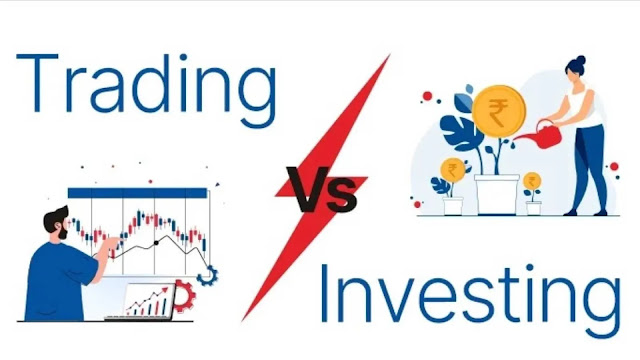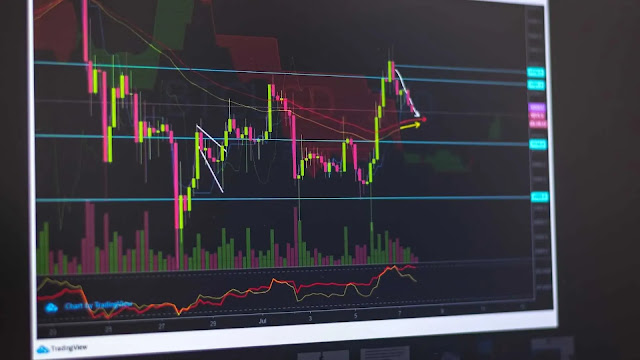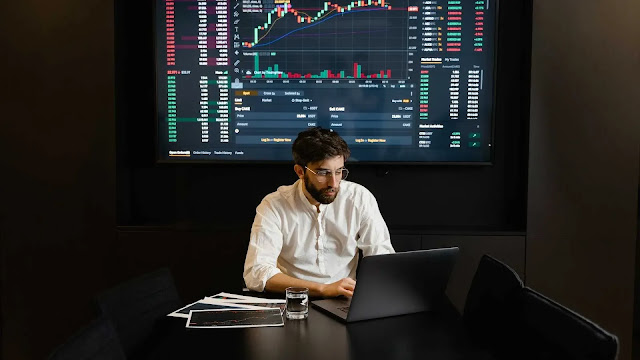Trading vs Investing - Which Strategy to Choose for Better Results?
In the world of money, there are two main ways people try to make more of it: trading and investing. Trading is like a fast race – people buy and sell stocks or other things quickly to make money from small changes in prices. On the other hand, investing is more like a slow and steady journey – people buy things to hold onto them for a long time, hoping they'll grow in value.
Choosing the right strategy is super important because it decides how you'll try to grow your money. This article will help you understand these strategies better and guide you on picking the right one for you. We'll take a look at what trading and investing really mean, why making the right choice matters, and give you a roadmap of what this article will cover.
 |
| Trader vs Investor - Which Strategy to Choose for Better Results? |
So, let's dive in to discover whether you should be a trader or an investor for a brighter financial future.
Understanding Trading
Trading is like a thrilling race in the financial world, where people buy and sell things like stocks, currencies, or commodities with the aim of making quick profits. Let's break down the key aspects of trading: Also Read - How Trading Can Shape Your Life's Trajectory?
 |
| Understanding Trading |
A. Definition and Characteristics of Trading
Trading involves buying and selling financial assets like stocks, bonds, or currencies in a short span of time. The main goal is to take advantage of small price fluctuations to make money. Traders often use charts, graphs, and technical analysis to predict these price movements.
B. Short-Term Focus
In trading, there are different styles based on how long a trader holds onto their assets. Day traders buy and sell within a single day, while swing traders hold onto assets for a few days or weeks. Scalpers are the quickest – they make lots of trades in a very short time to make tiny profits from each trade.
C. High Frequency of Transactions and Quick Decision-Making
Traders make a lot of transactions, sometimes even dozens in a single day. This means they need to be fast decision-makers, as markets can change in seconds. They use technology and computer programs to help them execute trades quickly.
D. Risks Associated with Trading
Trading can be risky due to the fast-paced nature of markets. Prices can swing wildly in a short time, leading to potential gains or losses. This volatility can be stressful and emotionally challenging for traders. The pressure to make quick decisions and the possibility of losing money can cause psychological stress.
In a nutshell, trading is all about quick actions and seizing short-term opportunities. However, it's important to note that while trading can yield profits, it also comes with its share of risks and demands a good deal of focus and nerve.
Exploring Investing
Investing is like planting seeds for a bountiful harvest in the future financial landscape. Let's delve into the essential components of investing: Also Read - Startup Success Blueprint.
 |
| Exploring Investing |
A. Definition and Characteristics of Investing
Investing is the art of buying assets like stocks, real estate, or bonds with the intention of holding onto them for an extended period. The main goal is to let your money grow over time, usually through the increasing value of the assets and any income they generate.
B. Long-Term Perspective
Investing has different styles too. Value investors look for undervalued assets that have potential to grow, while growth investors focus on companies with strong growth prospects. Dividend investors seek out assets that provide regular income in the form of dividends.
C. Emphasis on Fundamental Analysis and Company Performance
Investors pay attention to the fundamentals of the assets they're buying. They study things like a company's financial health, earnings potential, and market position. This thorough analysis helps them make informed decisions.
D. Benefits of Investing
One of the most magical things about investing is compound interest. Your money earns money, and that money earns more money – it's like a financial snowball that grows over time. Investing also tends to be less stressful than trading, as it doesn't require constant monitoring. Plus, it has the potential to create substantial wealth over the long run.
In summary, investing is like planting a tree that grows over time and provides shade for years to come. It's a patient and thoughtful approach to building wealth, with a focus on the long-term journey rather than quick gains. While it may not offer immediate rewards like trading, investing offers the possibility of steady growth and financial security.
Key Differences between Traders and Investors
Traders and investors might both be navigating the financial waters, but their boats sail on different currents. Let's take a closer look at the distinct aspects that set them apart: Also Read - The Path to Financial Freedom.
 |
| Key Differences between Traders and Investors |
A. Time Horizon
Traders have a short time horizon – they're focused on making quick gains by buying and selling assets in a short span. Investors, on the other hand, have a long-term perspective, aiming to build wealth gradually over years or decades.
B. Decision-Making Process
Traders need to make rapid decisions based on market trends and technical indicators. Their research tends to be quicker and more focused on immediate price movements. Investors, however, dig deep into fundamental analysis, studying a company's financials, industry trends, and long-term potential before making decisions.
C. Risk Tolerance
Trading often involves higher risks due to the fast-paced nature of markets. Traders might experience frequent ups and downs. Investors, with their long-term perspective, usually have a more balanced approach to risk, aiming for steady growth over time.
D. Monitoring and Involvement
Traders need to be vigilant at all times, as market conditions can change rapidly. They need to keep a constant eye on their positions. Investors, while still engaged, don't require the same level of constant monitoring. They review and adjust their portfolios periodically.
In a nutshell, traders are like sprinters in the financial race, chasing quick gains, while investors take the role of marathon runners, patiently building wealth over the long haul. Understanding these differences helps you choose the approach that aligns best with your financial goals and temperament.
Factors to Consider when Choosing a Strategy
Selecting the right financial strategy is like choosing the perfect tool for a job – it needs to fit just right. Here are the key factors to ponder before making your choice: Also Read - The Power of a Personalized Strategy.
 |
| Factors to Consider when Choosing a Strategy |
A. Personal Financial Goals and Objectives
Your goals steer the ship. Are you looking for quick profits or long-term growth? Defining what you want to achieve financially will guide your strategy.
B. Risk Tolerance and Psychological Temperament
Are you comfortable with high-risk, high-reward scenarios, or do you prefer a more stable path? Your comfort with risk and how well you handle market fluctuations play a big role.
C. Time Availability for Research and Monitoring
Trading demands quick decisions and constant attention. Investing allows for a more relaxed approach. Consider how much time you can dedicate to staying informed and making choices.
D. Knowledge and Expertise in Financial Markets
Are you a financial guru or just starting out? Trading requires a good understanding of market trends and technical tools. Investing requires solid knowledge of company fundamentals.
E. Market Conditions and Trends
Markets change like the weather. Some strategies work better in certain market conditions. Stay informed about current trends and how they align with your chosen approach.
In short, your strategy should be like a custom-made suit, tailored to your unique financial situation, personality, and goals. Reflect on these factors, and you'll be better equipped to make a choice that's in sync with your aspirations.
Pros and Cons of Trading
Trading can be like a fast-paced roller coaster ride – thrilling, but not without its twists and turns. Let's break down the advantages and drawbacks of this dynamic strategy: Also Read - Can Trading Lead to Wealth?
A. Pros
1. Potential for Quick Profits
Trading offers the chance to make rapid gains, sometimes even in a matter of minutes. If you're skilled at spotting market trends, you can seize opportunities for short-term profits.
2. Active Involvement and Skill Development
Trading demands constant engagement with the markets. This active participation can help you refine your analytical skills and deepen your understanding of how financial markets work.
B. Cons
1. High Stress and Emotional Toll
The fast pace of trading can be intense. Rapid price fluctuations and the pressure to make quick decisions can lead to high stress levels and emotional strain.
2. Increased Transaction Costs and Taxes
Frequent buying and selling can result in higher transaction costs, eating into your profits. Additionally, trading can have tax implications that need careful consideration.
In short, trading can offer exciting opportunities for those who thrive in a dynamic environment, but it's crucial to be aware of the potential downsides. The potential for quick profits comes hand in hand with higher stress levels and costs that need to be managed wisely.
Pros and Cons of Investing
Investing is like planting seeds that grow into sturdy trees – it takes time, but the rewards can be significant. Let's explore the upsides and downsides of this steady strategy: Also Read - Why Trading is Often Harder Than It Seems?
 |
| Pros and Cons of Investing |
A. Pros
1. Long-Term Wealth Accumulation
Investing is a gradual journey towards building wealth over time. As your investments grow and compound, they can potentially provide substantial financial security in the long run.
2. Reduced Stress and Emotional Decision-Making
Compared to the fast pace of trading, investing tends to be less stressful. Decisions are based on thorough analysis and long-term potential, reducing the emotional rollercoaster that comes with short-term trading.
B. Cons
1. Slower Returns Compared to Trading
Investing requires patience. While it can yield significant returns, they might take years to materialize, unlike the quick gains often seen in trading.
2. Limited Liquidity for Certain Investments
Some investments, like real estate or certain stocks, might not be easily converted to cash when needed. This lack of immediate liquidity can be a downside if you require quick access to your funds.
In a nutshell, investing is a marathon, not a sprint. The potential for steady, long-term growth and reduced stress make it an attractive option, but it requires a patient mindset and a willingness to wait for the rewards to unfold.
Making an Informed Decision
Selecting the right financial strategy is like planning a journey – you need a map and the right gear. Here's how to make a well-informed decision: Also Read - How Trading Sets Itself Apart from Gambling?
 |
| Making an Informed Decision |
A. Assessing Personal Financial Goals and Risk Tolerance
Start by knowing where you want to go. Clarify your financial goals – whether it's quick profits or long-term growth. Also, understand how comfortable you are with risks, as different strategies come with varying levels of uncertainty.
B. Aligning Strategy with Available Time and Resources
Consider how much time you can dedicate to your chosen approach. Trading demands constant attention, while investing requires periodic check-ins. Additionally, be aware of the financial resources you're willing to commit – some strategies may require more initial capital than others.
C. Considering a Hybrid Approach: Blending Trading and Investing
You don't have to pick just one strategy. Some people find success by blending trading and investing. This allows you to enjoy the potential quick gains of trading while also benefiting from the steady growth of long-term investments.
D. Importance of Continuous Learning and Adaptation
Financial markets are always evolving. Whether you choose trading, investing, or a mix, continuous learning is vital. Stay informed about market trends, economic changes, and new strategies. Adapt your approach as needed to stay on course.
Ultimately, the right strategy depends on your unique circumstances and goals. By evaluating your objectives, resources, and risk tolerance, you can choose a path that aligns with your aspirations and sets you on the road to financial success.
Conclusion
In the ever-changing world of finance, the choice between trading and investing is a decision that shapes your financial future. Each path comes with its own set of opportunities and challenges, and understanding your personal goals and temperament is key to making the right choice.
Trading offers the allure of quick profits and active engagement, but it demands a high level of skill, constant vigilance, and the ability to manage stress. Investing, on the other hand, embodies patience and the potential for long-term wealth accumulation. It's a journey that requires careful analysis, a steady hand, and a knack for adapting to market shifts.
 |
| Conclusion |
As you weigh these options, consider your own financial objectives, risk tolerance, and available resources. Your strategy should be a reflection of your unique circumstances and aspirations. Remember, it's not a one-size-fits-all decision – you can even blend trading and investing to create a tailored approach that suits you best.
Regardless of the path you choose, continuous learning and adaptation are vital. Financial markets are dynamic, and staying informed about trends, strategies, and shifts is essential for success. Whether you're chasing quick gains or patiently cultivating wealth, the journey is ongoing.
So, armed with insights into the world of trading and investing, make your decision wisely. Forge your financial path with confidence, knowing that the road you choose is a stepping stone towards realizing your dreams and securing a brighter financial future.

